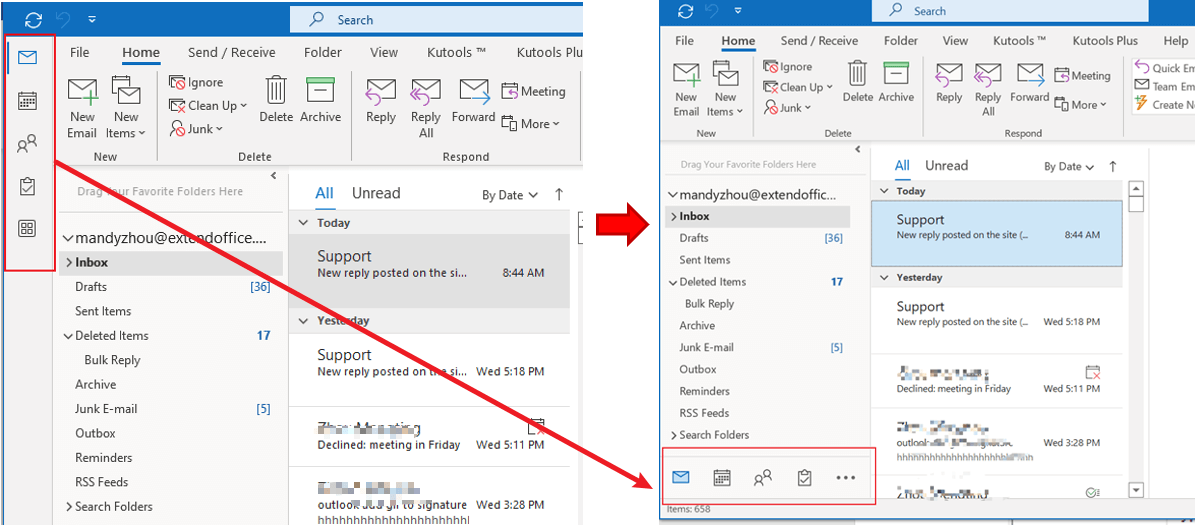
In the ever-evolving interface of Microsoft Outlook, users often find themselves needing to customize their workspace for efficiency and comfort. One such customization is moving the navigation pane to the bottom of the screen. This guide will walk you through the steps and tips to achieve just that, ensuring your Outlook is tailored to your preferences.
Understanding the Outlook Navigation Pane
The navigation pane in Outlook is your primary tool for navigating between mail, calendar, contacts, and other key features. By default, it’s located on the left side of the Outlook window. However, not everyone finds this placement convenient, and you might be wondering if you can move it to the bottom for better accessibility and to maximize your workspace.
Why Move the Navigation Pane?
Moving the navigation pane to the bottom can help users who prefer a more streamlined look or need to optimize their screen’s real estate. It’s particularly useful for those with wide monitors, as it allows for a more natural, horizontal eye movement.
Step-by-Step Guide to Moving the Navigation Pane
- Open Outlook Options: Start by opening your Outlook desktop app. Go to the “File” menu, select “Options” to open the Outlook Options dialog box.
- Access Advanced Options: In the Outlook Options dialog, navigate to the “Advanced” section.
- Adjust Outlook Panes: Look for the “Outlook Panes” section. Here, you’ll find an option to “Show apps in Outlook.” Unchecking this box will move your navigation pane to the bottom.
- Restart Outlook: For the changes to take effect, restart your Outlook application. Upon reopening, you should see the navigation pane at the bottom of your window.
Alternative Methods
While the above method works for many, updates to Outlook can change how settings are accessed or appear. If you’re using a version of Outlook where the “File” option is missing, or if you’re on the New Outlook, you might need to revert to the classic version or explore other customization options within the “View” tab.
Customizing Your Navigation Pane
Beyond moving it, Outlook allows for further customization of the navigation pane:
- Minimize or Expand: You can choose to minimize the navigation pane to a narrow strip or expand it for full access to its features.
- Rearrange Icons: Drag and drop the icons within the navigation pane to reorder them according to your preference.
- Show or Hide Sections: Collapse sections you use less frequently to keep your navigation pane tidy and focused on what’s important to you.
Conclusion
Customizing the navigation pane in Outlook by moving it to the bottom can significantly enhance your email management experience. By following the steps outlined above, you can tailor your Outlook interface to suit your personal preferences and workflow needs. Remember, the key to a productive workspace is making it your own.
FAQs
- Can I move the navigation pane to the bottom in all versions of Outlook?
- The ability to move the navigation pane to the bottom may vary based on the version of Outlook you’re using. The steps provided work for many desktop versions, but always check if your specific version supports this customization.
- Will moving the navigation pane affect my Outlook performance?
- No, moving the navigation pane is purely a visual customization and won’t affect the performance of Outlook.
- Can I revert the navigation pane back to its original position?
- Yes, you can always revert your changes by following the same steps and reselecting the default settings.
- Is it possible to customize the navigation pane on Outlook for Mac?
- The customization options for Outlook on Mac may differ. It’s best to explore the Outlook Preferences on your Mac for navigation pane settings.
- What should I do if I don’t see the option to move the navigation pane?
- If you’re unable to find the option, it’s possible that your version of Outlook does not support this customization, or the interface has been updated. Check for any available updates or consider reaching out to Microsoft support for assistance.